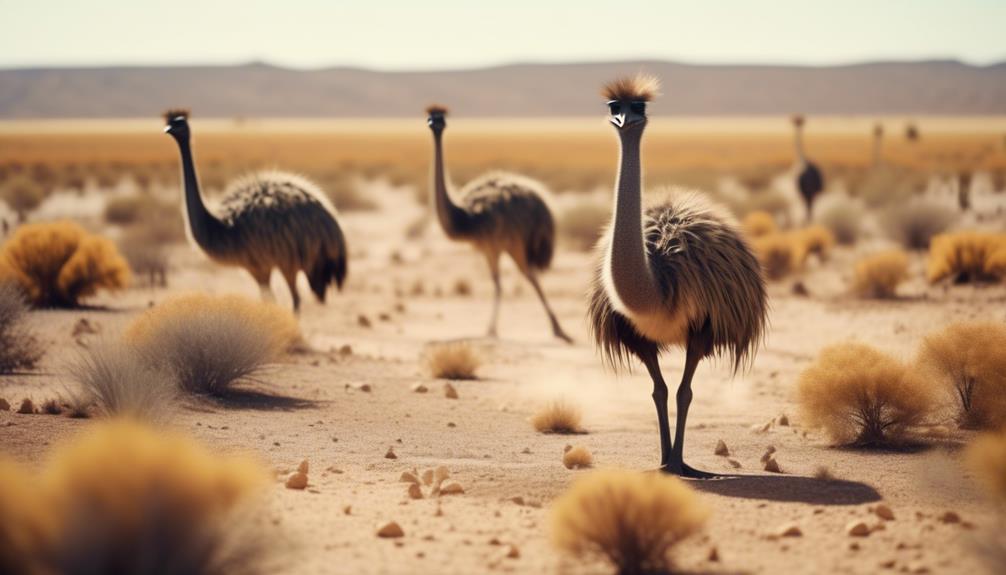
Imagine a vast, interconnected web of life, where each thread plays a crucial role in maintaining the delicate balance of nature. Now, picture this intricate tapestry slowly unraveling, thread by thread, due to the relentless force of climate change.
As temperatures rise and ecosystems shift, the impact on emu populations becomes increasingly concerning. From altering their behavior to challenging their ability to reproduce, climate change poses a multitude of threats to these fascinating creatures.
But what exactly are these threats, and how can we mitigate their devastating consequences?
Key Takeaways
- Changing temperatures and altered habitats due to climate change have significant impacts on emu behavior, including feeding patterns, breeding habits, and migration patterns.
- Emus are facing challenges in finding suitable nesting sites, leading to decreased egg viability and compromising their ability to reproduce successfully.
- Climate change has resulted in habitat fragmentation for emus, leading to disrupted migration patterns and conflicts with human settlements or other wildlife species.
- Limited food availability due to climate change can weaken emus and make them more susceptible to diseases and predation.
Changing Temperatures and Emu Behavior
Changing temperatures have a significant impact on the behavior of emus, affecting their feeding patterns, breeding habits, and overall population dynamics. As temperatures fluctuate, emus are forced to adapt their migration patterns. Emus typically migrate in search of food, moving to areas where vegetation is abundant. However, with changing temperatures, these migration patterns are becoming more unpredictable.
In response to rising temperatures, emus are altering their nesting patterns as well. Emus construct large nests on the ground, using twigs, leaves, and grass. These nests provide a safe space for their eggs to incubate. However, with changing temperatures, emus are finding it increasingly difficult to choose suitable nesting sites. Warmer temperatures can lead to increased predation and decreased egg viability. As a result, emus are being forced to seek out cooler and shaded areas for nesting, which can be challenging to find in changing environments.
Furthermore, changing temperatures can also impact the overall population dynamics of emus. As their migration and nesting patterns are disrupted, the ability of emus to reproduce successfully may be compromised. This can lead to a decline in population numbers over time.
Altered Habitats and Emu Distribution
Altered habitats and changes in emu distribution have been observed as a result of the shifting climate conditions. Climate change has led to habitat fragmentation, which has had a significant impact on the distribution of emus. Here are two key observations:
- Habitat fragmentation: The changing climate has resulted in alterations to the landscapes that emus traditionally inhabit. Rising temperatures and changing rainfall patterns have led to the drying up of wetlands and the expansion of arid regions. As a result, the emu's natural habitat has become fragmented, with isolated pockets of suitable habitat scattered across the landscape. This fragmentation makes it more difficult for emus to find suitable breeding grounds and resources, leading to a decline in their population.
- Emu migration: Emus are known for their ability to migrate over large distances in search of food and suitable breeding grounds. However, with the changing climate, their migration patterns have been disrupted. As habitats become unsuitable or disappear altogether, emus are forced to find new areas to migrate to. This can result in conflicts with human settlements or other wildlife species, further impacting their distribution.
These changes in emu distribution highlight the urgent need for conservation efforts and habitat restoration to ensure the long-term survival of this iconic species.
Food Availability and Emu Feeding Patterns

As the climate conditions continue to shift, the impact of altered habitats and changes in emu distribution extends to their food availability and feeding patterns. Emus have unique foraging adaptations and a diverse diet that enables them to survive in a variety of environments. They're primarily herbivores, consuming a range of plant materials such as grasses, fruits, seeds, and leaves. However, they're also known to eat insects and small vertebrates when vegetation is scarce.
With climate change, the availability of these food sources is being affected. As temperatures rise and rainfall patterns shift, the growth of vegetation is being altered, leading to changes in the distribution and abundance of plants that emus rely on. This poses a challenge for emus as they need to adapt their feeding patterns to find suitable and available food sources.
Competition for resources is also increasing among emus and other animals that share their habitat. As food becomes scarcer, emus may have to compete with other species for limited resources, which can impact their survival. Emus that are unable to find enough food may become weakened and more susceptible to diseases and predation.
Breeding Challenges and Emu Reproduction
Climate change has presented numerous challenges for emu reproduction, impacting their breeding patterns and success rates. As emus face the changing climate, they encounter several challenges that affect their ability to reproduce and maintain healthy populations. These challenges include:
- Changes in habitat: Climate change can lead to alterations in emu habitat, such as shifts in vegetation patterns and availability of suitable nesting sites. This can disrupt their breeding patterns and decrease reproductive success.
- Altered timing of breeding: With climate change, there are shifts in seasonal patterns, including changes in temperature and rainfall. These alterations can disrupt the emus' natural breeding cycles and affect their reproductive success.
It is crucial to understand and address these challenges faced by emus to ensure their long-term survival and reproductive success. Conservation efforts should focus on preserving and restoring their habitats, creating suitable nesting sites, and monitoring their breeding patterns.
Disease Outbreaks and Emu Health

Disease outbreaks pose significant threats to emu health, impacting their overall populations and reproductive success. Emus, like any other species, are susceptible to various diseases that can spread rapidly within a population. In order to maintain the health and well-being of emus, disease prevention plays a crucial role.
One of the key factors in disease prevention is understanding the immune response of emus. Emus have a unique immune system that allows them to withstand certain diseases. However, if a disease outbreak occurs, it can overwhelm their immune system, leading to severe consequences. Therefore, it's essential to monitor emu populations regularly and take proactive measures to prevent disease outbreaks.
Implementing strict biosecurity measures is an effective approach to prevent the spread of diseases. This involves controlling the movement of emus, minimizing contact with other animals, and ensuring proper hygiene practices. Additionally, vaccination programs can be implemented to enhance the immune response of emus and protect them from specific diseases.
To ensure the long-term survival of emus, it's crucial to prioritize disease prevention. By understanding their immune response and implementing effective measures, we can mitigate the impact of disease outbreaks on emu populations. This won't only safeguard their health but also contribute to their overall reproductive success and population growth.
Conservation Efforts to Protect Emu Populations
Conservation efforts play a vital role in safeguarding the future of emu populations. To ensure the well-being and survival of these magnificent birds, various initiatives are being undertaken. Here are two key approaches that are being implemented:
- Emu population monitoring: Regular monitoring of emu populations is crucial to gather essential data on their numbers, distribution, and health. By closely tracking their population trends, scientists can identify any decline or threat to their survival. This information helps in formulating effective conservation strategies and targeted interventions to protect the emus.
- Habitat restoration initiatives: Emus heavily rely on specific habitats for breeding, feeding, and shelter. However, habitat loss and degradation due to human activities have posed significant challenges to their survival. To counteract this, conservation organizations are actively involved in restoring and preserving emu habitats. These efforts include reforestation projects, removal of invasive species, and conservation of vital water sources. By restoring their natural habitats, emus have a better chance of thriving and adapting to the changing climatic conditions.
Through focused emu population monitoring and habitat restoration initiatives, we can contribute to the long-term conservation of these remarkable birds. These efforts not only protect emu populations but also help maintain the ecological balance of their habitats. By working together, we can ensure a future where emus continue to grace our landscapes and inspire us with their resilience and beauty.
Frequently Asked Questions
How Does Climate Change Affect the Overall Ecosystem That Emus Inhabit?
Climate change disrupts the overall ecosystem that emus inhabit by causing habitat loss. As temperatures rise and weather patterns shift, their habitats are altered, making it harder for emus to find food and shelter.
Are There Any Other Species That Are Negatively Impacted by Climate Change, in Addition to Emus?
Other species, in addition to emus, are also negatively impacted by climate change. This includes a wide range of wildlife, leading to negative effects on their populations and even contributing to species extinction.
What Are Some Specific Examples of Behavioral Changes Observed in Emus as a Result of Changing Temperatures?
When temperatures change, emus exhibit behavioral adaptations such as altering their foraging patterns and reducing activity during extreme heat. Physiological changes, like increased panting and seeking shade, help them cope with the changing climate.
How Do Emus Adapt to Altered Habitats and Changes in Their Distribution?
You gotta wonder, how do those emus adapt to new homes and all that moving around? Well, let me tell you, these clever birds have strategies like adjusting their breeding patterns to cope with climate change. Impressive, huh?
Are There Any Measures in Place to Monitor and Track the Long-Term Effects of Climate Change on Emu Populations?
Monitoring methods and research initiatives are in place to track the long-term effects of climate change on emu populations. These measures help scientists understand how emus adapt to altered habitats and changes in their distribution.
Conclusion
Protecting Emu populations from the impacts of climate change requires proactive conservation efforts.
By understanding the changing temperatures' effect on Emu behavior, altered habitats' impact on distribution, and food availability's influence on feeding patterns, we can develop strategies to mitigate these challenges.
Additionally, addressing breeding challenges and disease outbreaks will be crucial for ensuring Emu reproduction and health.
Through collective actions and conservation initiatives, we can safeguard these majestic birds and preserve their populations for future generations.




